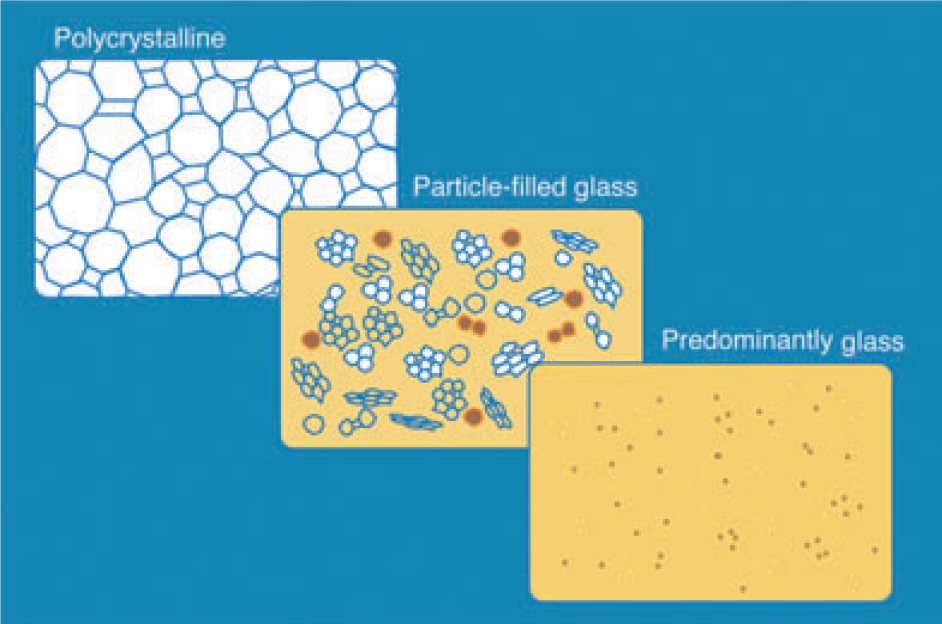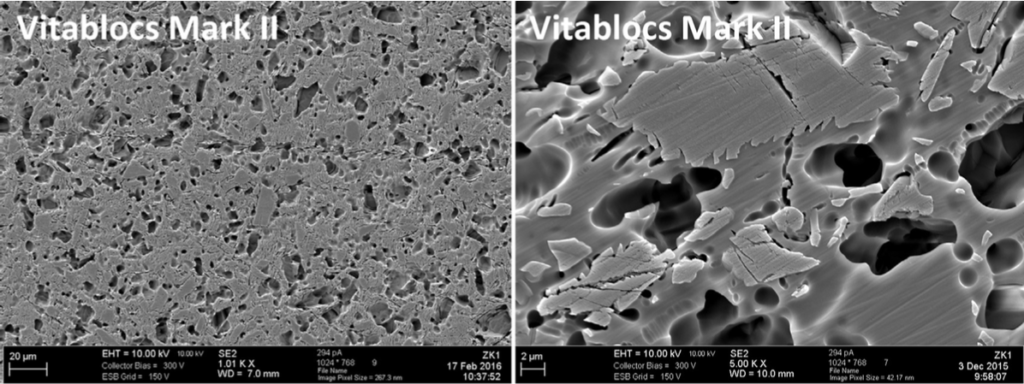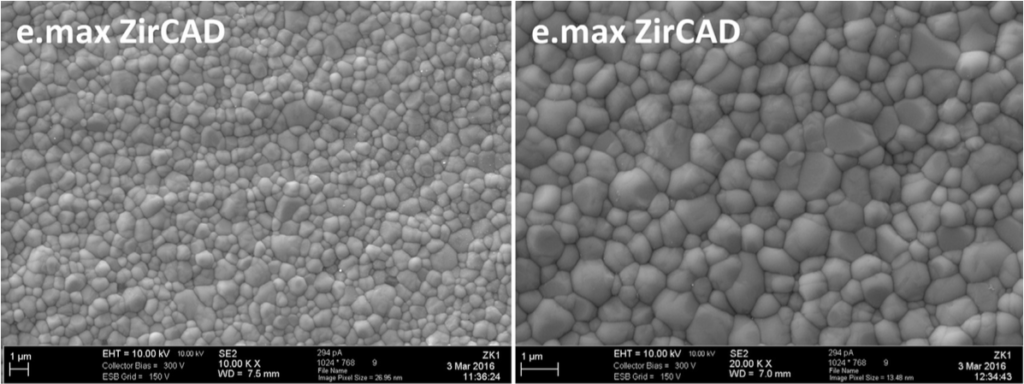上一篇介紹了陶瓷微結構的基本概念,其排列及結晶會影響陶瓷的物理及光學性質,本篇文章繼續以微結構為分類,進一步細分不同種類陶瓷的特性。
本系列文章希望帶大家認識陶瓷的結構、分類及特性,進而幫助醫師及技師在臨床上選擇適合的材料。
上篇請參考:牙科陶瓷材料基礎介紹(一)— 陶瓷微結構
相關文章:IDS 2017 CAD/CAM 新材料總覽 – 瓷塊篇
前情提要
上篇有介紹到在牙科陶瓷的發展歷程中,一開始出現的是玻璃陶瓷 (glass ceramics) ,其原子排列散亂,透光度佳但強度表現較弱。後來為增加強度或調整性質,就在玻璃陶瓷裡面增加一些結晶顆粒 (particle-filled glasses) ,使得陶瓷的強度增加許多,接著更是發展出全結晶態的多晶陶瓷 (polycrystalline ceramics) ,其結晶排列緻密整齊,強度佳但透光度不好(微結構示意圖請見圖一)。
陶瓷的分類方式有很多種,如製程、用途及組成等等。這裏以微結構的分類方式是因為陶瓷的組成及微結構與其表現出來的特性很有關係,如透光度、物理強度、可酸蝕性、可加工性(車床車削時的邊緣破損程度)等等,以下的文章會介紹這幾種分類、特性及市面上常見的 CAD/CAM 用瓷塊。

玻璃陶瓷 (Glass ceramics)
由長石 (feldspar) 這種鋁矽玻璃 (aluminosilicate glasses) 為主,並含高嶺土 (kaolin) 及石英 (quartz) 等成份。是早期金屬陶瓷牙冠 (porcelain fused to metal crown) 上的鑲面 (veneered) 材料。透光性很好,可用氫氟酸酸蝕,但是強度較弱。
市面上的 CAD/CAM 瓷塊有 Vita 公司出的 Mark II、TriLuxe、TriLuxe Forte、RealLife 等。

粒子充填玻璃陶瓷 (Particle-filled glasses)
為含有結晶顆粒的玻璃陶瓷,裡面還含有玻璃成分,所以跟玻璃陶瓷一樣是可以酸蝕的。以下介紹含不同結晶顆粒的玻璃陶瓷材料:
白榴石 (leucite) 強化玻璃陶瓷:
為了改善長石材料的強度及調整熱膨脹係數而發展出來的陶瓷材料。此材料的熱膨脹係數跟金屬內冠的熱膨脹係數較匹配(比金屬稍微大一些),現在的金屬陶瓷牙冠常使用白榴石玻璃陶瓷為鑲面 (veneered) 材料。當長石在升高溫度時,會產生白榴石的結晶顆粒,使強度上升,且此顆粒的透光性質與長石很接近,透光度仍佳。市面上的 CAD/CAM 瓷塊有 Ivoclar 公司出的 Empress CAD 。
Empress-CAD-1024x380.png)
二矽酸鋰 (lithium disilicate) 強化玻璃陶瓷:
在玻璃陶瓷內添加體積百分比約 70% 的二矽酸鋰成份。其強度表現比長石材料高很多,透光度也佳,在傳統製程的話就是大家愛用的 e.max Press。市面上的 CAD/CAM 瓷塊有 Ivoclar 公司出的 e.max CAD 。
e.max-CAD-1024x380.png)
氧化鋯強化矽酸鋰 (zirconia-reinforced lithium silicates, ZLS) :
因為二矽酸鋰陶瓷在 CAD/CAM 車削加工的過程當中邊緣破損 (chipping) 的狀況較嚴重,因此有添加氧化鋯的改良材料問世,如 Densply 公司出的 Celtra Duo(請參考:CAD/CAM 陶瓷材料 – Celtra Duo)以及 Vita 公司出的 Suprinity(請參考:CAD/CAM 陶瓷材料 – VITA Suprinity)。
Celtra-Duo-1024x379.png)
多晶陶瓷 (Polycrystalline ceramics)
這種陶瓷的排列相當整齊,強度表現很好。有氧化鋯 (zirconia) 跟氧化鋁 (alumina)。
氧化鋯已是許多醫師相當熟悉的材料,尤其有相變增韌 (transformation toughening) 的性質(氧化鋯透過晶格轉變的體積變化來關閉裂痕的自癒特性)可以抑制陶瓷表面的裂痕延伸 (crack propagation) 。目前只有 CAD/CAM 加工方式。
許多廠商都有出氧化鋯瓷塊,如 Densply 出的 Cerec Zirconia、Vita 出的 YZ T/HT、Ivoclar 公司的 e.max ZirCAD 等等。

樹脂陶瓷複合材料 (Resin/ceramic hybrid)
脆性的陶瓷在車削時有邊緣破損 (chipping) 問題,有些人就想到加入樹脂成份增加它的彈性模數 (modulus of elasticity) ,目前知道它對車削的破損的確較小,但是可拋光性、染色及色澤穩定性可能是問題。
目前市面上的 CAD/CAM 瓷塊有 3M 公司出的 Lava Ultimate、Vita 公司出的 Enamic 以及 GC 公司出的 Cerasmart。
enamic-1024x381.png)
結論
經過陶瓷材料的微結構分類,我們可以對瓷塊有最基本的了解:玻璃陶瓷類透光度佳但強度弱;添加結晶顆粒的玻璃陶瓷強度增加,有數種不同的添加顆粒,其光學性質與強度也有所不同;而氧化鋯等多晶陶瓷則強度最佳而最不透光。同時,為了因應 CAD/CAM 的車削加工方式,有許多改良材料或新材料的出現,有了這些微結構的基本概念,我們才可以進一步討論各種瓷塊的性質。
Reference
1. Anusavice K.J., Shen C., Rawls H.R. (2013) Phillips’ science of dental materials. 12nd ed. St. Louis, Mo: Elsevier/Saunders. Ch18: Dental ceramics.
2. JR Kelly, P Benetti (2011) Ceramic materials in dentistry: historical evolution and current practice. Australian Dental Journal 56:(1 Suppl): 84–96.
3. Belli R., Wendler M., de Ligny D., and Cicconi M.R., et al. (2017) Chairside CAD/CAM materials. Part 1: Measurement of elastic constants and microstructural characterization. Dental Materials. 33(1):84-98.
Doris Chang (張維庭) is a lecturer at CEREC Asia and the current leader of the Tooth Faerie Club.
